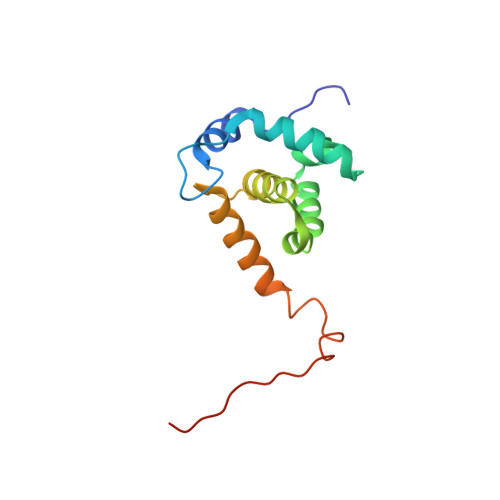Trio engagement via plasma membrane phospholipids and the myristoyl moiety governs HIV-1 matrix binding to bilayers.
Vlach, J., Saad, J.S.(2013) Proc Natl Acad Sci U S A 110: 3525-3530
- PubMed: 23401539
- DOI: https://doi.org/10.1073/pnas.1216655110
- Primary Citation of Related Structures:
2LYA, 2LYB - PubMed Abstract:
Localization of the HIV type-1 (HIV-1) Gag protein on the plasma membrane (PM) for virus assembly is mediated by specific interactions between the N-terminal myristoylated matrix (MA) domain and phosphatidylinositol-(4,5)-bisphosphate [PI(4,5)P(2)]. The PM bilayer is highly asymmetric, and this asymmetry is considered crucial in cell function. In a typical mammalian cell, the inner leaflet of the PM is enriched in phosphatidylserine (PS) and phosphatidylethanolamine (PE) and contains minor populations of phosphatidylcholine (PC) and PI(4,5)P(2). There is strong evidence that efficient binding of HIV-1 Gag to membranes is sensitive not only to lipid composition and net negative charge, but also to the hydrophobic character of the acyl chains. Here, we show that PS, PE, and PC interact directly with MA via a region that is distinct from the PI(4,5)P(2) binding site. Our NMR data also show that the myristoyl group is readily exposed when MA is bound to micelles or bicelles. Strikingly, our structural data reveal a unique binding mode by which the 2'-acyl chain of PS, PE, and PC lipids is buried in a hydrophobic pocket whereas the 1'-acyl chain is exposed. Sphingomyelin, a major lipid localized exclusively on the outer layer of the PM, does not bind to MA. Our findings led us to propose a trio engagement model by which HIV-1 Gag is anchored to the PM via the 1'-acyl chains of PI(4,5)P(2) and PS/PE/PC and the myristoyl group, which collectively bracket a basic patch projecting toward the polar leaflet of the membrane.
- Department of Microbiology, University of Alabama at Birmingham, Birmingham, AL 35294, USA.
Organizational Affiliation:

















